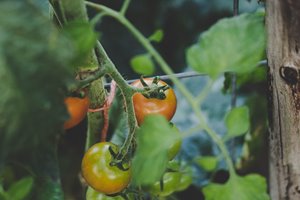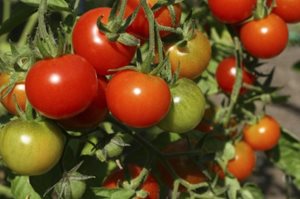Tomatoes are a type of nightshade plant and, contrary to popular belief, they are - in fact - a fruit. They are a versatile food forming the basis of many popular cuisines, including Italian, Greek, Middle Eastern and French. From blitzing them into soups and pasta sauces to adding slices to salads, the possibilities with tomatoes are endless.
Fresh, vine-ripened tomatoes have a much stronger flavour than the average salad variety, making them a tastier choice. As they’re one of the easiest crops to grow, harvesting your own tomatoes can be very rewarding.
Whether you want to stock up on homemade soup for winter, or simply enjoy freshly picked produce, our guide has everything you need to know about how to grow tomatoes.
 How to plant tomatoes
How to plant tomatoes
The first thing to consider when planting seeds for tomatoes is what type of plant you want to grow. From bite-size cherry tomatoes to plump heirloom varieties, there are a range of options to choose from, with each requiring its own individual tomato plant care.
Typically, tomatoes grow in two ways:
Cordon (also known as indeterminate) tomatoes grow up to six feet tall and require tall supports to ensure they grow in the right direction. They can easily be grown in a polytunnel or greenhouse, or in a sunny area outside. They’ll grow either in the ground using a raised bed or in a large plant pot beside a wall which faces south. They are the ideal plant to grow if you’re lacking in space, as they grow upwards rather than outwards and produce a significant amount of fruit. However, Cordon tomatoes need regular maintenance, such as watering, feeding, tying to supports and pruning.
Bush (also known as determinate) tomatoes are shorter and wider, making them perfect for growing in pots or hanging baskets. These require much less maintenance than Cordon tomatoes, only watering and feeding. The stems will only need support if they are heavy with fruit, and there’s no need to prune Bush tomatoes or pinch out any side shoots. As they can be grown in pots and baskets, it’s possible to grow this variety even if you don’t have a garden at all.
Whichever tomato variety you choose, begin by sowing your seeds indoors. Take a small pot and fill it with seed compost. Water the compost thoroughly, then sow three or four seeds on the surface of the compost. Cover the seeds with vermiculite and store the pot at around 18°C. You can use a heated propagator if you have one. If not, simply cover the pot with a clear plastic bag and place it on the windowsill (provided it will receive warmth and sunlight). Keep an eye on the pot and wait for the seedlings to appear (this usually takes around two weeks), then remove the plastic bag and place the pot somewhere it will get plenty of sunlight.
After another couple of weeks, the seedlings can be separated into individual pots:
- Fill each pot with multi-purpose compost and water them well, then use a dibber or blunt stick to make a hole in the middle of the pots.
- Move one seedling at a time, using the dibber to support its roots. Hold the plant by the leaf, as the stem is fragile and could easily snap.
- Carefully lower the seedling into the new hole. If there are any leggy bits, bury it up to the first pair of leaves. Press the soil down gently so as not to damage the roots.
Keep your tomato plants in a polytunnel or on a windowsill which gets plenty of sunlight − either will be fine provided the temperature is at least 16°C – and water the plants regularly. After a month, the first flowers should open and you’ll be able to plant the crops in their final position.
How long do tomatoes take to grow?
Before you start planting seeds, it’s helpful to have an idea of when your tomatoes will be ready to pick. The amount of time needed for your fruit to grow will depend on the environment you’re growing them in and the tomato variety. For example, a cherry tomato is smaller in size than an heirloom tomato, often ripening faster than the larger fruit. On the whole, the number of days it takes to grow tomatoes varies between 60 to 100 days.
 When to plant tomatoes in the UK
When to plant tomatoes in the UK
Every crop responds differently to our British climate, so even if you’re a seasoned gardener, you’ll find it helpful to know when to plant tomatoes for optimal yield. Tomatoes thrive in hot weather, meaning summer is the best time to plant tomatoes in the UK. If you’re planning to grow your crops in a polytunnel, late February to mid-March is the ideal time to sow.
However, if your tomatoes will be grown outside, wait a little longer and sow your seeds around late March to early April. Being grown in warm conditions will be the difference between your tomatoes being ripe and juicy or green and bitter, so plan ahead to ensure you pick the best time to plant your tomatoes.
Growing tomatoes in a polytunnel
With British weather being so unpredictable, it makes sense to take precautions to improve the chance of your crops developing healthily and to protect them from the elements. Adjusting the growing environment of your tomatoes by using a polytunnel can help them reach their full potential. A polytunnel warms the soil beneath it, enabling you to plant your tomatoes a bit earlier. Warmer soil improves the growth of young tomatoes, making them more likely to mature into beautifully ripe, tasty fruit. Growing tomatoes in a polytunnel can also provide protection from wind and rain for your crops, without reducing their access to the sun. Polytunnels also prevent pests and animals like cats and birds from trampling on the seeds or eating your produce.
Get in touch
For advice on selecting the right polytunnel for tomatoes, browse our range available here. If you have any questions, contact us on 01282 811250 or email info@premierpolytunnels.co.uk and one of our friendly experts will be happy to assist.